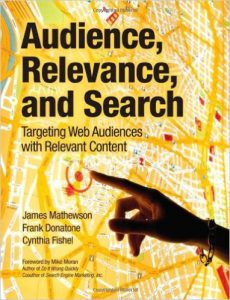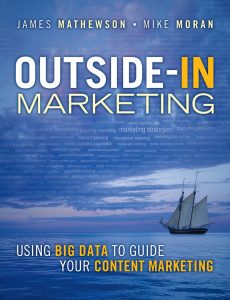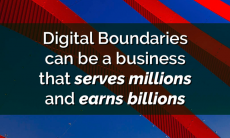As Mike announced on April 21, 2016, we recently published a book together called Outside-In Marketing: Using Big Data to Guide Your Content Marketing. It has been a long and winding road to get this book done, and we are very proud and more than a little relieved to see it in print.
The Story of the Book
 It all started with my other book: Audience, Relevance and Search: Targeting Web Audiences With Relevant Content (ARS), which I co-authored with Frank Donatone and Cyntia Fishel. I’m also very proud of that book, but it didn’t sell very well for a couple of reasons:
It all started with my other book: Audience, Relevance and Search: Targeting Web Audiences With Relevant Content (ARS), which I co-authored with Frank Donatone and Cyntia Fishel. I’m also very proud of that book, but it didn’t sell very well for a couple of reasons:
- It was ahead of its time. When it was published in 2010, most SEOs were trying to game Google’s algorithm. This book is not about that at all. It is about a content strategy that’s kind of the opposite of how SEO was practiced at the time. It is about using search query data as a proxy for audience interest about topics relevant to your company, and building content that satisfies those interests. Shortly after the book was published, Google took steps to make it much more difficult to game the system with its Panda and Penguin algorithms. This led to a barrage of articles about how SEO is dead. In reality, SEO is not dead, it just needs to be practiced as I preach in ARS. Somehow that message never made it to the masses.
- It was too deep. Part of the reason my other book didn’t make it to the masses is its technical nature. It is a book about using data from search to write relevant content for your audience. Writers and content strategists found it useful (though they hated that their creativity could be tempered by math), but executives got lost in the data and never really made it to the point: the web represents a whole new way of engaging with audiences and companies will either adapt to the new model or perish.
Rather than writing a second edition that corrected these issues, I decided to write a follow-on book specifically for the executive audience. But I knew I could not do this alone. So I approached Mike, who wrote the foreword of ARS, to help me write this one. I can’t tell you how pleased I am about that decision. It turns out we complement each other well. I have deep editorial and content strategy experience, and Mike can go deep on just about everything else. We also have a good mix of experiences with a variety of clients and contacts.
What’s in the Book?
For a relatively short book, it contains a lot of content. The chapters are organized by the typical executive journey towards embracing outside-in marketing:
- Risk aversion: Any new paradigm demands a major shift in thinking. Going from inside-out to outside-in marketing is a huge paradigm shift. A lot of the executives we have worked with initially resist the new paradigm. They are used to buying advertising and getting a small, but significant, return on investment. They like to say, “I did that,” when it comes to acquiring customers with a set budget, and incrementally improving on that spend. Content marketing represents a big risk for them.
The first chapter addresses this risk aversion head on by giving real-life examples of how other executives have gotten out of their comfort zones to get orders of magnitude more ROI from content marketing with the same dollars they spent on ads. - Confusion: Content marketing has its share of critics. Most of them use straw man arguments to depict content marketing in a negative light and then criticize the practice as characterized. In this atmosphere, it’s important to define the practice in neutral terms and evaluate it on its merits. That’s what we do in Chapter 2. The truth is, a lot of marketing that passes for content marketing is poorly done. But done right, it can be a very effective way to acquire new customers and nurture them towards healthy customer relationships. The rest of the book is about how to do it well.
- Culture: Many executives want to adopt content marketing, but fear that their organizations are not ready for it. Many marketing departments are collections of folks who have a narrow understanding of marketing (the one where advertising is front and center) and struggle to see the bigger picture. This chapter is about proven ways of changing the culture and getting everyone to at least try outside-in marketing.
- Technology: One of the biggest challenges to getting outside-in marketing adopted is math. Marketers are not fond of pouring over spreadsheets that help them numerically understand what content to produce and how it performs once they do. In inside-out marketing, marketers leave that to the agency. Outside-in requires that marketers be comfortable with using math, but it need not be in gorpy spreadsheets. Modern tools give the marketer the analysis they need to make good content decisions without having to crunch numbers in a spreadsheet. This chapter shows them how.
- Strategy: The variety of content marketing strategies can also be a barrier to adoption and success. It is an old practice dating back at least to Michelin Guides and Betty Crocker. As digital forms of content marketing have grown, the variety has exploded. Hence the need for a content strategy to help marketers connect the content needs of clients and prospects with their business objectives. To do this, we simplify the problem by focusing on inbound content marketing strategy. By that, we mean understanding your buyers well enough to intercept them on their information journeys to progress them towards purchasing your products. If you create a pleasing client journey, they might even become advocates for your brand. This is the most effective marketing content strategy from our experience.
- Design: The greatest differentiator between success and failure in outside-in marketing is the point of execution: where clients and prospects interact with content. A common trap is to view inbound marketing design as akin to advertising design, which tends to focus on iconic imagery and minimizes text. In our experience, that doesn’t work. Designs that work minimize graphics and give a healthy space for text, as long as the text is relevant to the audience. This chapter explains why these design patterns work, but also encourages the reader not to merely take our word for it. Rather, we encourage the reader to use testing as the foundation of good user experience design. By all means start with proven designs, but test them against others to refine what works for your audience.
 That’s what’s in the book from a topical perspective. We also made a conscious choice to lighten up the presentation. We start every chapter with a story from our experience as consultants. We end every chapter with an interview with an industry leader in the field, including Ben Edwards, Mark Schaefer, Bill Hunt, Rob Key, Kristina Halvorson, and Jared Spool. These interviews bring together diverse—in some cases divergent—perspectives on content marketing with our own perspective.
That’s what’s in the book from a topical perspective. We also made a conscious choice to lighten up the presentation. We start every chapter with a story from our experience as consultants. We end every chapter with an interview with an industry leader in the field, including Ben Edwards, Mark Schaefer, Bill Hunt, Rob Key, Kristina Halvorson, and Jared Spool. These interviews bring together diverse—in some cases divergent—perspectives on content marketing with our own perspective.
I really hope you enjoy this book and that it helps you transform your marketing organization towards a more client-centric approach. Click the book picture and use code IBM5565 for 35% off!




